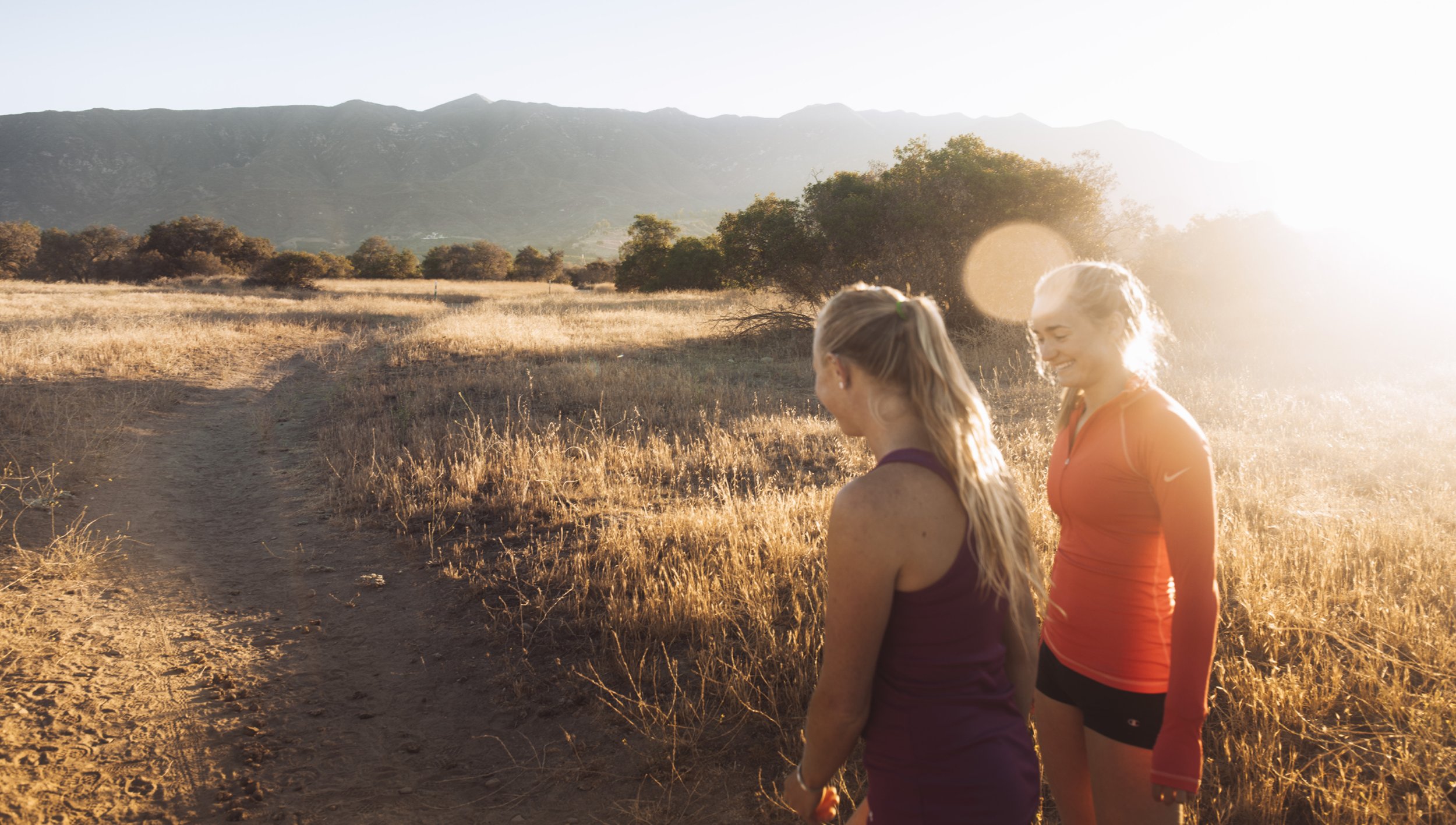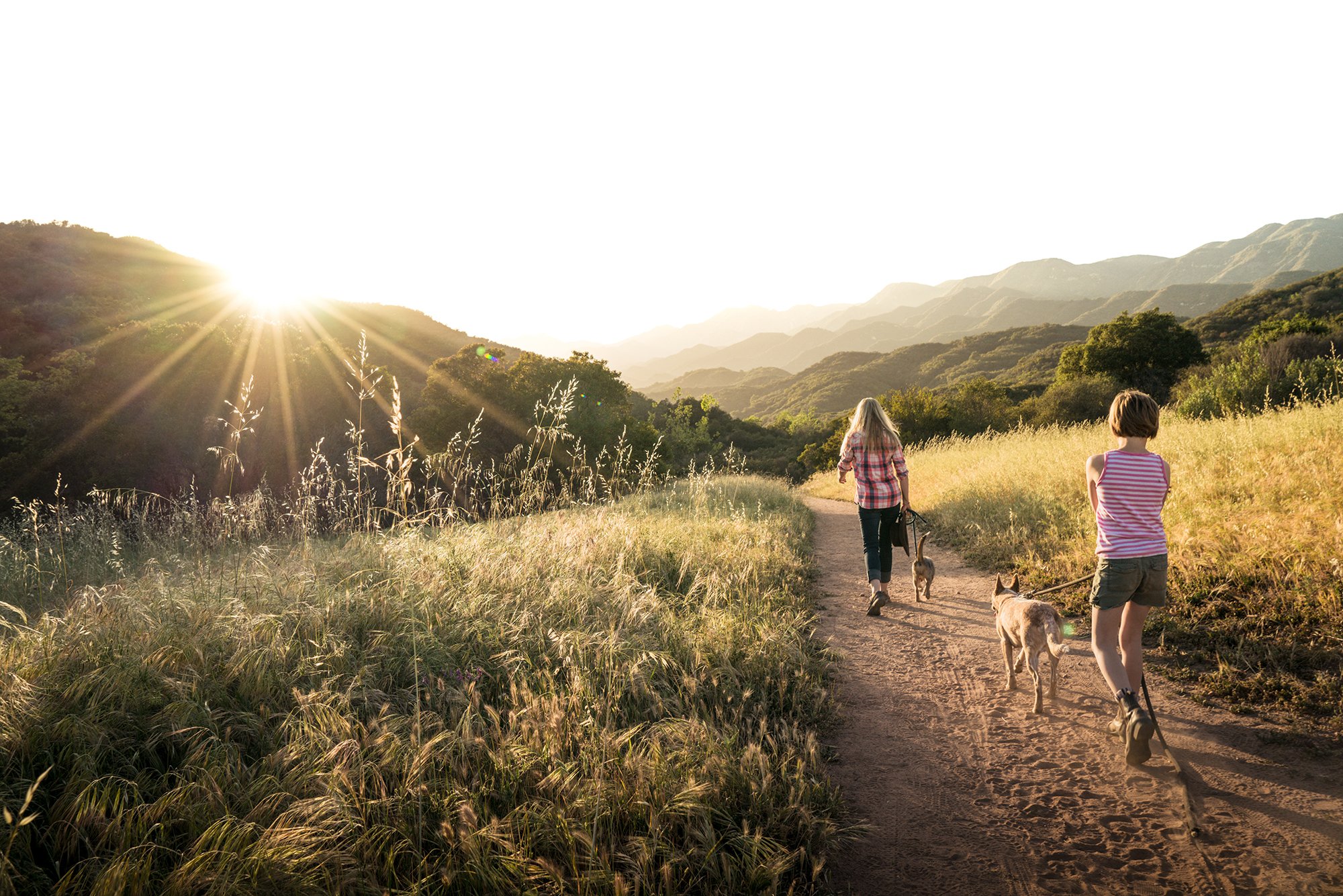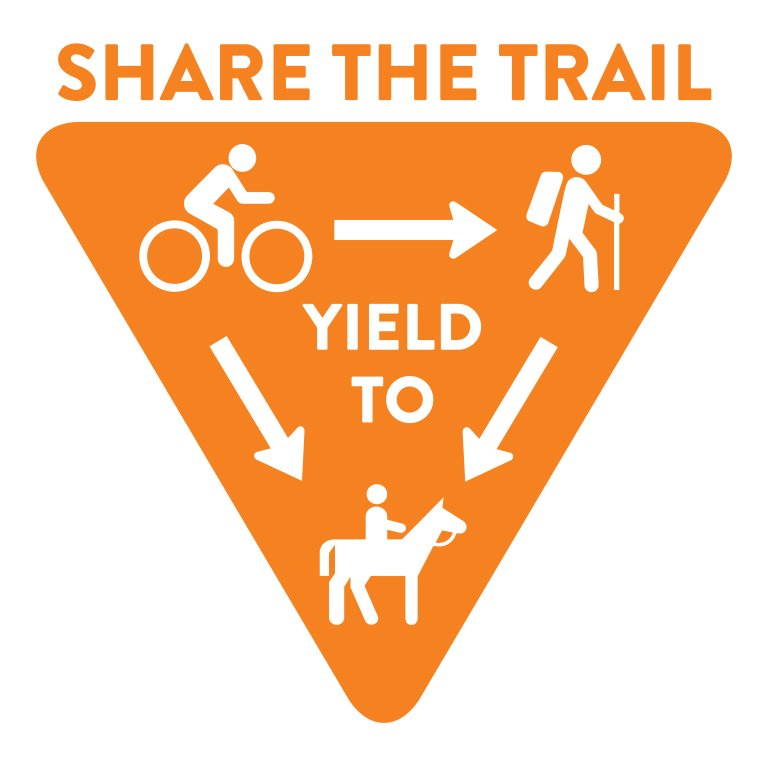
safety & Etiquette
Due to an increasing interest in outdoor recreation, OVLC trails are receiving more traffic than ever before. OVLC trails are primarily multi-use trails, open to equestrians, mountain bikers, and hikers/runners.
Your adherence to these guidelines while on OVLC trails ensures the safety and enjoyment of all fellow preserve users.

Trail right-of-way
Please be courteous to other users, share the trail, and follow these guidelines when you are using OVLC trails:
RIDERS USE CAUTION
Mountain bikers and equestrians should ride with caution at a safe and controlled speed. All OVLC trails are bi-directional and users should anticipate oncoming traffic. Be prepared to yield.
Mountain bikers and equestrians should make themselves known when encountering or attempting to pass other users and when approaching blind turns.
Please have a bell on your bike/horse or verbally announce yourself.
ELECTRIC BIKES
Class 1 are allowed on OVLC trails.
Class 2 and 3 e-bikes are not allowed on OVLC trails.
BE AWARE OF YOUR SURROUNDINGS
Always make sure you can hear what is going on around you. If you are listening to music or talking on the phone, please make sure you only use one earbud. This will allow you to hear the rattle of a snake, the bells on a mountain bike, or other trails users needing your attention.
STAY ON TRAIL
Stay on the trail—because you may be trampling sensitive vegetation and stressing fragile, arid ecosystems. Only step off the trail when allowing other users to pass.
Don’t cut switchbacks as they easily erode hillsides and damage surrounding vegetation.
Muddy trail closure at the mouth of Wills Canyon
RESPECT TRAIL CLOSURES
Respect trail closures—We occasionally close muddy trails to mountain bikers and equestrians. Riding on muddy trails widens the trail and destroys the trail tread. Not to mention repairs are costly for the OVLC to maintain and take away funds from other projects like creating new trails and acquiring new land.
If you come across a puddle on the trail, walk or ride through it rather than going around it to avoid widening the trail.
RESPECT PRIVATE PROPERTY
A few of our trails pass through or adjacent to private property. It is imperative that we all respect the privacy of neighboring landowners in an effort to prevent any access disputes. Do not trespass.
LEAVE NO TRACE
Practice ‘Leave No Trace’ principles:
Plan ahead and be prepared.
Leave what you find.
Pack out what you pack in.
Do not litter. Use the trash cans at our trailheads.
Respect wildlife.
Be considerate of other users.
Leash your dog and pick up the poop.
Nobody likes coming across poop on the trail.
MOUNTAIN LIONS
There has been a lot of mountain lion and coyote activity in the valley recently. Please remember to have your dog leashed at all times (this is an OVLC rule) and we highly recommend carrying an air horn. Noise is your best defense against a mountain lion. We do not condone shooting a mountain lion and weapons are not allowed on the preserves.
If the cat attacks and you have to fight back, throw rocks at its body. Injuring the mountain lion’s head can lead to loss of sight and cognitive function that can actually provoke the cat to become a greater threat to other users and their pups. Plus, we do not want to harm these beautiful creatures. This is their home and they are an important keystone species of our local ecosystem. Mountain lion attacks are rare, but due to the increased activity on the preserves and around town, it’s best to be on high alert.
To learn more about mountain lions, visit ovlc.org/mountain-lions
HEAT SAFETY
Staying safe in the heat is crucial, especially when enjoying outdoor activities on the preserves. The Ojai Valley Land Conservancy Preserves are stunning, but safety should always come first when enjoying outdoor activities, especially in warmer climates. Familiarizing yourself with these heat safety measures can help ensure a fun and secure outdoor experience.
Preparing for the Heat
-
Carry plenty of water. Aim to drink even before you feel thirsty.
Avoid excessive caffeine or alcohol, as they can dehydrate you.
-
Wear lightweight, light-colored, and loose-fitting clothing to help your body stay cool.
Use hats, sunglasses, and sunscreen to protect against sunburn.
-
Schedule outdoor activities during the cooler parts of the day, like early morning or evening.
Take breaks in shaded or cool areas regularly
Safety Tips During Outdoor Recreation
-
Heat Exhaustion: Symptoms include heavy sweating, weakness, dizziness, nausea, headache, and fainting.
Heatstroke: This is a medical emergency. Symptoms include a high body temperature (above 103°F), confusion, rapid pulse, hot and dry skin (no sweating), and unconsciousness. Call emergency services immediately if you suspect heatstroke.
-
Use cooling towels, misters, or seek shade frequently to cool down.
If possible, plan activities near water sources or carry a spray bottle to mist yourself.
-
Rest in shaded or air-conditioned areas periodically, especially during intense physical activity.
Don’t push yourself too hard in extreme heat.
-
Consider less strenuous activities during high-temperature periods.
If you're feeling unwell due to the heat, stop and rest.
-
1. Be Mindful of Your Group:
Keep an eye on friends, family, or fellow hikers for signs of heat-related illnesses.
Encourage each other to drink water and take breaks.2. Know Your Limits:
Understand your body's tolerance to heat and act accordingly.
If you're new to the area or exercise, acclimate gradually to the heat.3. Carry a Fully Charged Phone:
Ensure you have a charged phone to call for help in case of emergencies.4. Stay Informed:
Check the weather forecast and heat advisories before heading out.
Keep track of how your body feels and adjust your activities accordingly.
Enjoying the beautiful Ojai Valley Land Conservancy Preserves comes with the responsibility of staying safe in the heat. Prioritize hydration, dress appropriately, and plan outdoor activities during cooler hours. Recognize signs of heat-related illnesses, take regular breaks, and stay cool in shaded areas. Always keep an eye on your group, know your limits, and stay informed about weather conditions. By following these simple guidelines, you can ensure a pleasant and safe outdoor adventure while exploring the preserves.
If you do encounter a coyote that’s acting aggressively:
Do not turn your back or try to run away
Stand tall, appear as big as possible and make noise
Keep eye contact with the coyote
Stay calm and back away slowly
While not recommended during denning season, if all else fails, a hazing approach can be taken to scare off the coyote. Hazing entails yelling, waiving your arms, making other noises like using whistles or bells, using pepper spray if handy, and throwing rocks or sticks at the coyote with the intent to scare it away, not to harm it.
Coyote attacks on humans are rare but they happen occasionally. In human attack incidents, it often turns out that the offending coyote was being fed by people. In other instances, people were bitten while trying to rescue their free-roaming pet from a coyote attack. For you and your dog’s safety, it is a best practice to please leash your dog and keep them close to you when visiting the preserves. Please do not feed wildlife. Less often, people are bitten by cornered coyotes, or even more rarely, rabid coyotes.
If you happen to encounter an aggressive coyote on our preserves, please report it to info@ovlc.org.

what we do
Our mission is to protect and restore the natural landscapes of the Ojai Valley forever.



